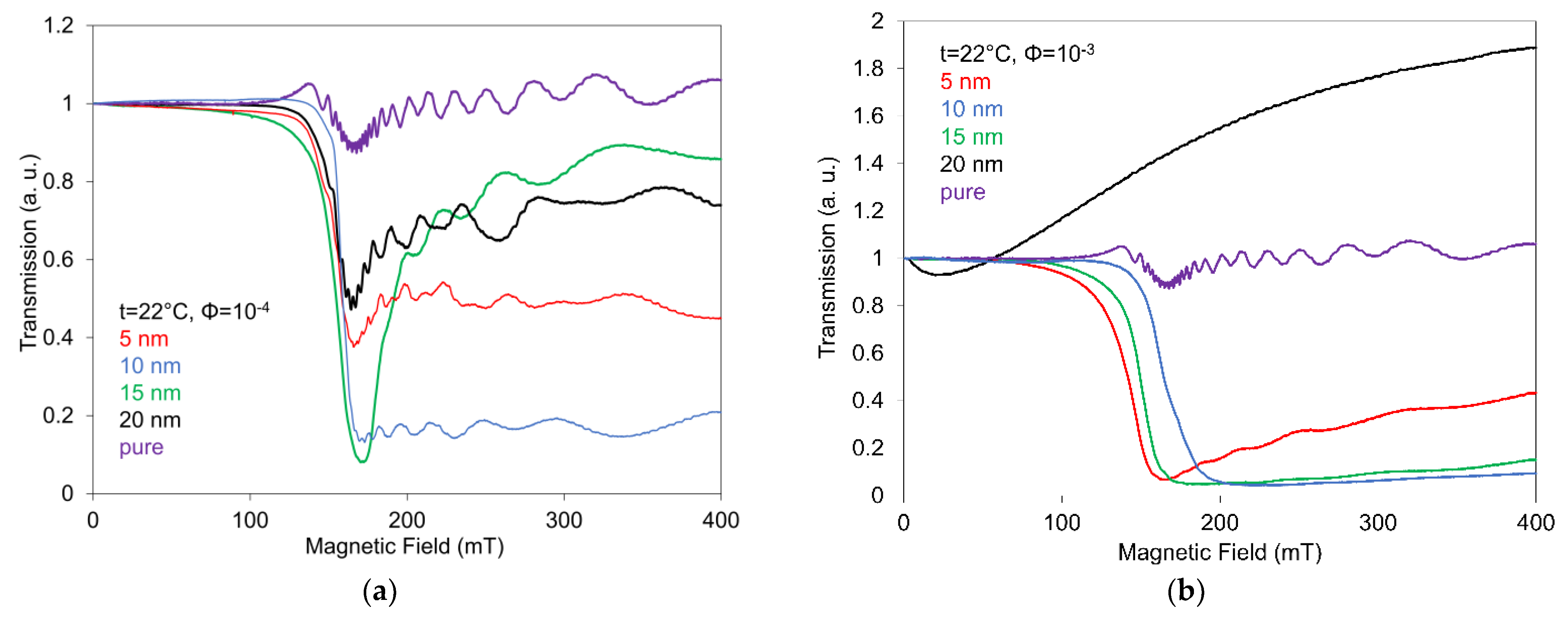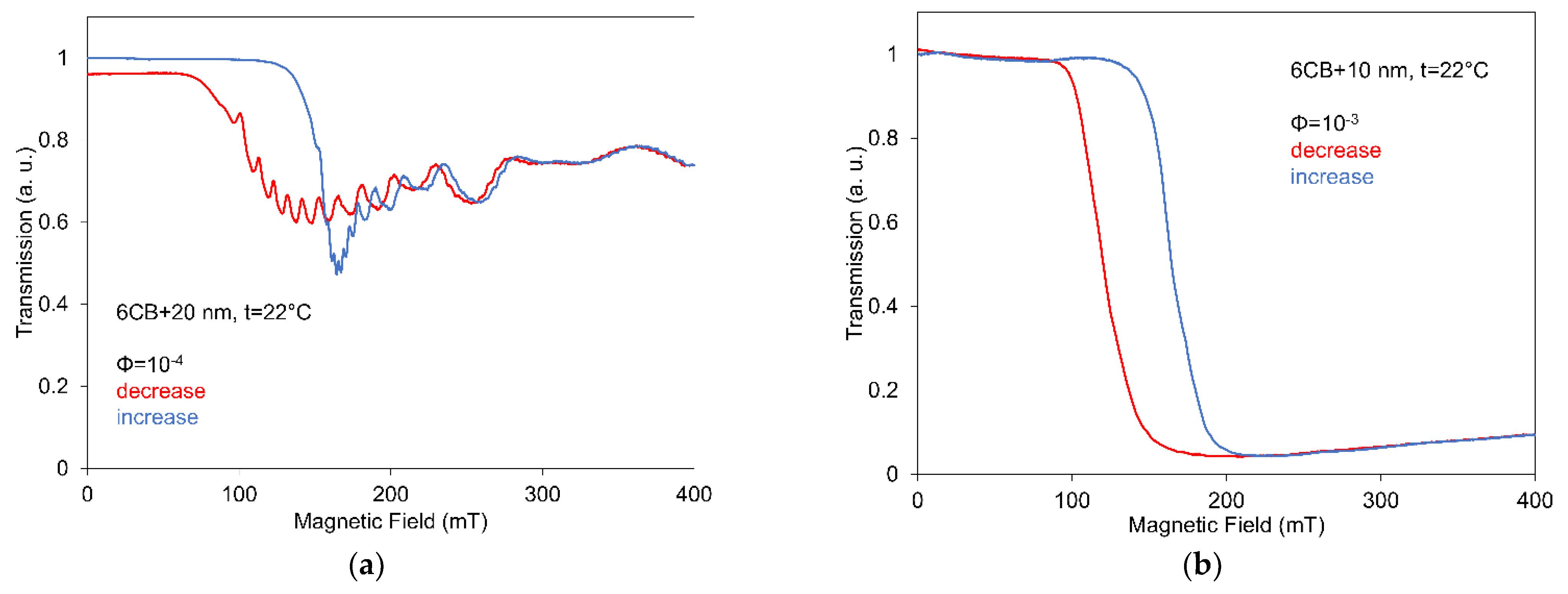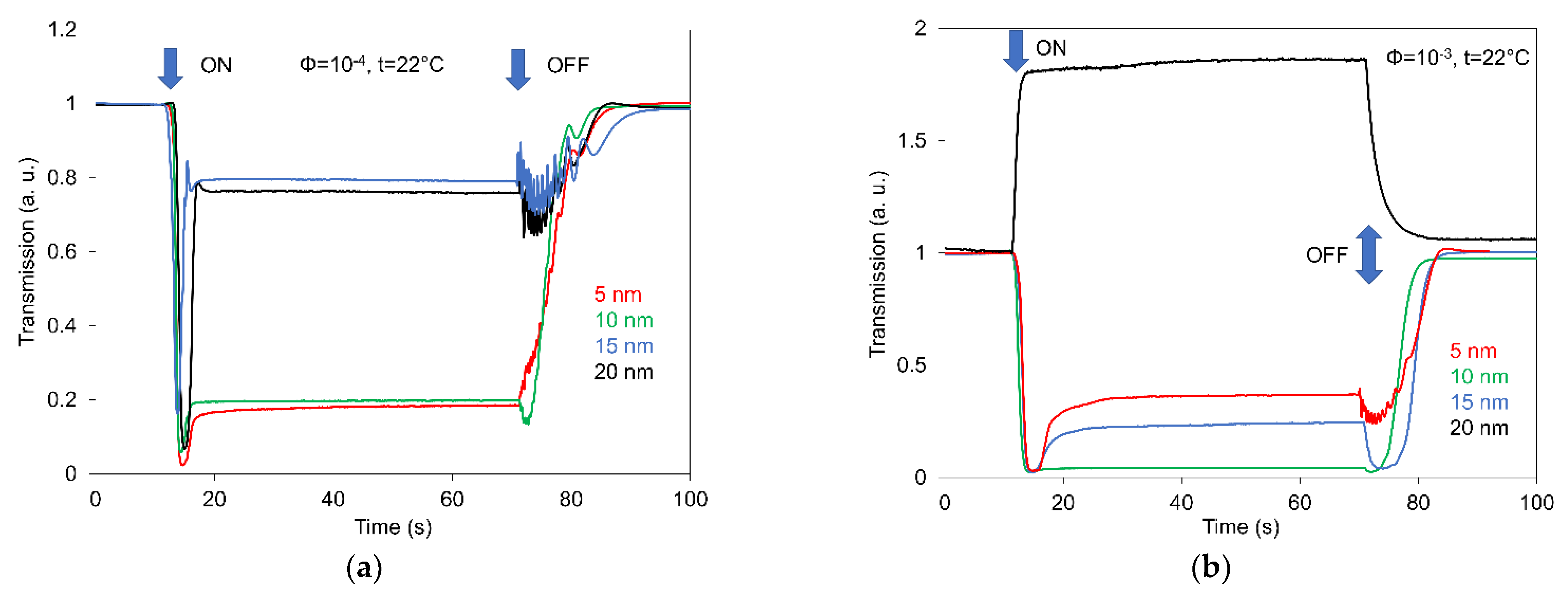Role of Magnetic Nanoparticles Size and Concentration on Structural Changes and Corresponding Magneto-Optical Behavior of Nematic Liquid Crystals
Abstract
1. Introduction
2. Experimental
3. Results and Discussion
4. Conclusions
Author Contributions
Funding
Conflicts of Interest
References
- Lagerwall, P.; Scalia, G. Liquid Crystals with Nano and Micro; World Scientific: Singapore, 2017; Volume I. [Google Scholar]
- Jeevanandam, J.; Barthoum, A.; Chan, Y.S. Review on nano and nanostructured materials: History, sources, toxicity and regulations. Beilstein J. Nanotechnol. 2018, 9, 1050. [Google Scholar] [CrossRef]
- Hegmann, T.; Qi, H.; Marx, V.M. Nano in liquid crystals:synthesis, self-assembly, defect formation and potential applications. J. Inorg. Organomet. Polym. Mater. 2007, 17, 483. [Google Scholar] [CrossRef]
- Brochard, F.; de Gennes, P.G. Theory of magnetic suspensions in liquid crystals. J. Phys. 1970, 31, 691. [Google Scholar] [CrossRef]
- Liebert, J.; Martinet, A. Coupling between nematic lyomesophases and ferrofluids. J. Phys. Lett. 1979, 40, 363. [Google Scholar] [CrossRef]
- Burylov, S.V.; Raikher, Y.L. Macroscopic Properties of Ferronematics Caused by Orientational Interactions on the Particle Surfaces. I. Extended Continuum Model. Mol. Cryst. Liq. Cryst. 1995, 258, 107–122. [Google Scholar] [CrossRef]
- Burylov, S.V.; Raikher, Y.L. Macroscopic properties of ferronematics caused by orientational interactions on the particle surfaces II, Behavior of real ferronematics in external fields. Mol. Cryst. Cryst. 1995, 258, 123–141. [Google Scholar] [CrossRef]
- Tomašovičová, N.; Timko, M.; Mitróová, Z.; Koneracká, M.; Rajňak, M.; Éber, N.; Tóth-Katona, T.; Chaud, X.; Jadzyn, J.; Kopčanský, P. Capacitance changes in ferronematic liquid crystals induced by low magnetic fields. Phys. Rev. E 2013, 87, 014501. [Google Scholar] [CrossRef]
- Tomašovičová, N.; Kopčanský, P.; Koneracká, M.; Závišová, V.; Timko, M.; Éber, N.; Tóth-Katona, T.; Jadzyn, J. The structural transitions in 6CHBT-based ferronematic droplets. J. Phys. Condens. Matter 2008, 20, 204123. [Google Scholar] [CrossRef] [PubMed]
- Zakhlevnykh, A.N.; Lubnin, M.S.; Petrov, A.N. A simple model of liquid-crystalline magnetic suspension of anisometric particles. J. Magn. Magn. Mater. 2017, 431, 62–65. [Google Scholar] [CrossRef]
- Zakhlevnykh, A.N.; Petrov, D.A. Orientational bistability and magneto-optical response in compensated ferronematic liquid crystals. J. Magn. Magn. Mater. 2016, 401, 188. [Google Scholar] [CrossRef]
- Lisjak, D.; Mertelj, A. Anisotropic magnetic nanoparticles: A review of their properties, syntheses and potential applications. Prog. Mater. Sci. 2018, 95, 286–328. [Google Scholar] [CrossRef]
- Petrescu, E.; Cirtoaje, C. Electric Properties of Multiwalled Carbon Nanotubes Dispersed in Liquid Crystals and Their Influence on Freedericksz Transitions. Nanomaterials 2022, 12, 7111. [Google Scholar] [CrossRef]
- May, K.; Eremin, A.; Stannarius, R.; Szabó, B.; Börzsönyi, T.; Appel, I.; Behrens, S.; Klein, S. Exceptionally large magneto-optical response in dispersions of plate-like nanocrystallites and magnetic nano. J. Magn. Magn. Mater. 2017, 431, 79–83. [Google Scholar] [CrossRef]
- Katiyar, R.; Pathak, G.; Srivastava, A.; Herman, J.; Manohar, R.; Katiyar, R.; Pathak, G.; Srivastava, A.; Herman, J.; Manohar, R. Analysis of electro-optical and dielectric parameters of TiO2 nano dispersed nematic liquid crystal. Soft Matter 2018, 16, 126–133. [Google Scholar] [CrossRef]
- Hakobyan, M.R.; Hakobyan, R.S. Lowering of the magnetic Fréedericksz transition threshold in nematic liquid crystals doped with ferromagnetic nano. J. Contemp. Phys. (Arm. Acad. Sci.) 2011, 46, 116–118. [Google Scholar] [CrossRef]
- Gdovinova, V.; Tomašovicová, N.; Éber, N.; Tóth-Katona, T.; Závišová, V.; Timko, M.; Kopčanský, P. Influence of the anisometry of magnetic nanoparticles on the isotropic-nematic phase transition. Liq. Cryst. 2014, 41, 1773–1777. [Google Scholar] [CrossRef][Green Version]
- Kopčanský, P.; Gdovinová, V.; Burylov, S.; Burylova, N.; Voroshilov, A.; Majorošová, J.; Agresti, F.; Zin, V.; Barison, S.; Jadzyn, J.; et al. The influence of goethite nanorods on structural transitions in liquid crystal 6CHBT. J. Magn. Magn. Mater. 2018, 459, 26–32. [Google Scholar] [CrossRef]
- Csach, K.; Juríková, A.; Miškuf, J.; Tomašovicová, N.; Gdovinová, V.; Závišová, V.; Kopčanský, P.; Éber, N.; Fodor-Csorba, K.; Vajda, A. Kinetics of nematic to isotropicphase transition in liquid crystal doped with magnetic nano. Acta Phys. Pol. A 2017, 131, 949–951. [Google Scholar] [CrossRef]
- Gorkunov, M.V.; Osipov, M.A. Mean-field theory of a nematic liquid crystal doped with anisotropic nano. Soft Matter 2011, 7, 4348–4356. [Google Scholar] [CrossRef]
- Zakutanská, K.; Lacková, V.; Tomašovičová, N.; Burylov, S.; Burylova, N.; Skosar, V.; Juríková, A.; Vojtko, M.; Jadzyn, J.; Kopčanský, P. Nanoparticle’s size, surfactant and concentration effects on stability and isotropic-nematic transition in ferronematic liquid crystal. J. Mol. Liq. 2019, 289, 111125. [Google Scholar] [CrossRef]
- Tomašovičová, N.; Burylov, S.; Gdovinová, V.; Tarasov, A.; Kováč, J.; Burylova, N.; Voroshilov, A.; Kopčanský, P.; Jadzyn, J. Magnetic Freedericksz transition in a ferronematic liquid crystal doped with spindle magnetic nanoparticles. J. Mol. Liq. 2018, 267, 390–397. [Google Scholar] [CrossRef]
- Bury, P.; Veveričík, M.; Černobila, F.; Kopčanský, P.; Timko, M.; Závišová, V. Study of Structural Changes in Nematic Liquid Crystals Doped with Magnetic Nano Using Surface Acoustic Waves. Crystals 2020, 10, 1023. [Google Scholar] [CrossRef]
- Häsler, M.; Nadasi, H.; Feneberg, M.; Marino, S.; Giesselmann, F.; Behrens, S.; Eremin, A. Magnetic tilting in nematic liquid crystals driven by self-assembly. Adv. Funct. Mater. 2021, 31, 2101847. [Google Scholar] [CrossRef]
- Burylov, S.V.; Raikher, Y.L. Magnetic Fredericksz Transition in a Ferronematic. J. Magn. Magn. Mater. 1993, 122, 62–65. [Google Scholar] [CrossRef]
- Burylov, S.V.; Zakhlevnykh, A.N. Analytical description of 2D magnetic Freedericksz transition in a rectangular cell of a nematic liquid crystal. Eur. Phys. J. E 2016, 39, 65. [Google Scholar] [CrossRef] [PubMed]
- Zakhlevnykh, A.N.; Petrov, D.A. Magnetic field induced orientational transitions in soft compensated ferronematics. Phase Transit. 2014, 87, 1–18. [Google Scholar] [CrossRef]
- Kopčanský, P.; Tomašovičová, N.; Timko, M.; Závišová, V.; Tomčo, L.; Jadzyn, J. The Sensitivity of Ferronematics to External Magnetic Fields. J. Phys. Conf. Ser. 2010, 200, 072055. [Google Scholar] [CrossRef]
- Bury, P.; Veveričík, M.; Černobila, F.; Molčan, M.; Zakuťanská, K.; Kopčanský, P.; Timko, M. Effect of Liquid Crystalline Host on Structural Changes in Magnetosomes Based Ferronematics. Nanomaterials 2021, 11, 2643. [Google Scholar] [CrossRef]
- Lee, W.; Wang, C.H.-Y.; Shih, Y.-C.H. Effects of carbon nanosolids on the electro-optical properties of a twisted nematic liquid-crystal host. Appl. Phs. Lett. 2004, 85, 513–515. [Google Scholar] [CrossRef]
- Si, G.; Zhao, Y.; Leong, E.S.P.; Liu, Y.J. Liquid-crystal-enabled Active Plasmonics. Materials 2014, 7, 1296–1317. [Google Scholar] [CrossRef] [PubMed]
- Bury, P.; Veveričík, M.; Kopčanský, P.; Timko, M.; Mitróová, Z. Structural Changes in Liquid Crystals Doped with Functionalized Carbon Nanotubes. Phys. E 2018, 103, 53–59. [Google Scholar] [CrossRef]
- Fernandes, P.R.G.; Mukai, H.; Laczkowski, I.M. Magneto-optical effect in lyotropic liquid crystal doped with ferrofluid. J. Magn. Magn. Mater. 2015, 289, 115–117. [Google Scholar] [CrossRef]
- Mukai, H.; Shibli, S.M.; Fernandes, P.R.G. Orientational order studies by magneto-optical and light-effects in lyotropic liquid crystal. J. Mol. Liq. 2007, 135, 53–56. [Google Scholar] [CrossRef]
- Mertelj, A.; Lisjak, D. Ferromagnetic nematic liquid crystals. Liq. Cryst. Rev. 2017, 5, 1–33. [Google Scholar] [CrossRef]
- Podoliak, N.; Buchnev, O.; Buluy, O.; D’Alessandro, G.; Kaczmarek, M.; Reznikov, Y.; Sluckin, T.J. Macroscopic optical effects in low concentration ferronematics. Soft Matter 2011, 7, 4742. [Google Scholar] [CrossRef]
- Bury, P.; Veveričík, M.; Kopčanský, P.; Timko, M.; Závišová, V. Effect of spherical, rod-like and chain-like magnetic nano on magneto-optical response of nematics. Acta Phys. Pol. A 2019, 36, 101–106. [Google Scholar] [CrossRef]
- Rupnik, P.M.; Lisjak, D.; Čopič, M.; Mertelj, A. Ferromagnetic liquid crystals for magnetic field visualization. Liq. Cryst. 2015, 42, 1684–1688. [Google Scholar] [CrossRef]
- Prshin, A.M.; Gunyakov, V.A.; Zyryanov, V.Y.; Shabanov, V.F. Electric and Magnetic Field-Assisted Orientational Transitions in the ensembles of Domains in a Nematic Liquid Crystal on the Polymer Surface. Int. J. Mol. Sci. 2014, 15, 7838. [Google Scholar] [CrossRef]
- Sutorin, V.S.; Krakhalev, M.N.; Prischepa, O.O.; Zyryanov, V.Y. Electricaly controlled local Fredericksz transition in a layer of a nematic liquid crystal. JETP 2012, 96, 511–516. [Google Scholar] [CrossRef]
- Zakutanská, K.; Petrov, D.; Kopčanský, P.; Wegłowska, D.; Kopčanský, N. Fréedericksz Transitions in 6CB Based Ferronematics—Effect of Magnetic Nano Size and Concentration. Materials 2021, 14, 3096. [Google Scholar] [CrossRef]
- Bury, P.; Veveričík, M.; Černobila, F. For the present nonpublished results of SAW investigation. 2022.
- Abbasov, M.E.; Carlisle, G.O. Effect of carbon nanotubes on electro-optical properties od dye-doped nematic liquid crystal. J. Mater. Electron. 2012, 23, 712–717. [Google Scholar] [CrossRef]
- Cirtoaje, C.; Petrescu, E. Measurement of magnetic anisotropy of multiwalled carbon nanotubes in nematic host. Phys. E 2016, 84, 244–248. [Google Scholar] [CrossRef]
- Chen, S.-H.; Amer, N.M. Observation of Macroscopic Collective Behavior and New Texture in Magnetically Doped Liquid Crystals. Phys. Rev. Lett. 1983, 51, 2298–2301. [Google Scholar] [CrossRef]







Publisher’s Note: MDPI stays neutral with regard to jurisdictional claims in published maps and institutional affiliations. |
© 2022 by the authors. Licensee MDPI, Basel, Switzerland. This article is an open access article distributed under the terms and conditions of the Creative Commons Attribution (CC BY) license (https://creativecommons.org/licenses/by/4.0/).
Share and Cite
Bury, P.; Veveričík, M.; Černobila, F.; Tomašovičová, N.; Zakuťanská, K.; Kopčanský, P.; Timko, M.; Jarošová, M. Role of Magnetic Nanoparticles Size and Concentration on Structural Changes and Corresponding Magneto-Optical Behavior of Nematic Liquid Crystals. Nanomaterials 2022, 12, 2463. https://doi.org/10.3390/nano12142463
Bury P, Veveričík M, Černobila F, Tomašovičová N, Zakuťanská K, Kopčanský P, Timko M, Jarošová M. Role of Magnetic Nanoparticles Size and Concentration on Structural Changes and Corresponding Magneto-Optical Behavior of Nematic Liquid Crystals. Nanomaterials. 2022; 12(14):2463. https://doi.org/10.3390/nano12142463
Chicago/Turabian StyleBury, Peter, Marek Veveričík, František Černobila, Natália Tomašovičová, Katarína Zakuťanská, Peter Kopčanský, Milan Timko, and Markéta Jarošová. 2022. "Role of Magnetic Nanoparticles Size and Concentration on Structural Changes and Corresponding Magneto-Optical Behavior of Nematic Liquid Crystals" Nanomaterials 12, no. 14: 2463. https://doi.org/10.3390/nano12142463
APA StyleBury, P., Veveričík, M., Černobila, F., Tomašovičová, N., Zakuťanská, K., Kopčanský, P., Timko, M., & Jarošová, M. (2022). Role of Magnetic Nanoparticles Size and Concentration on Structural Changes and Corresponding Magneto-Optical Behavior of Nematic Liquid Crystals. Nanomaterials, 12(14), 2463. https://doi.org/10.3390/nano12142463





